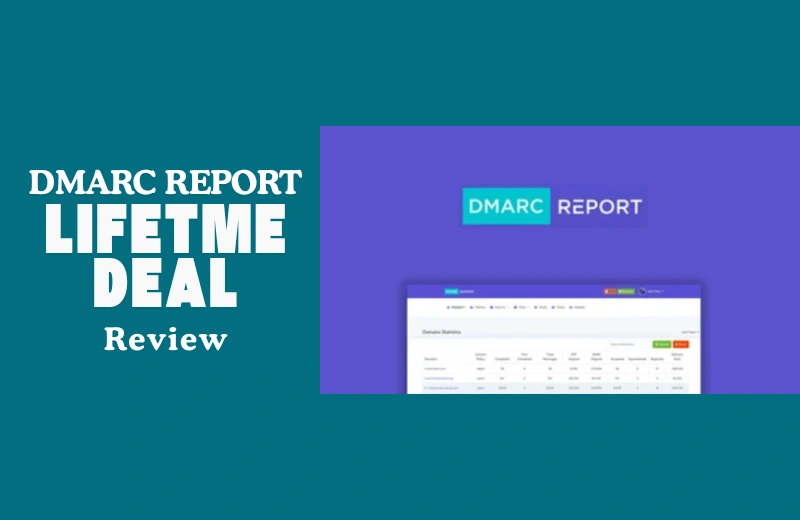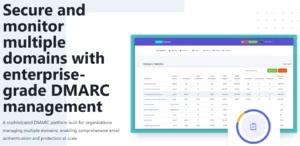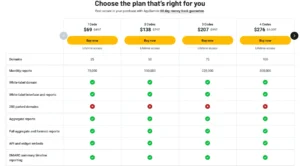Ever feel like you’re flying blind when it comes to email security? I’ve been there—digging through confusing DNS records, losing sleep over spoofing attacks, and wondering why my emails were landing in spam. That’s when I stumbled across the DMARC Report Lifetime Deal, and honestly, it changed everything. After years of managing client domains, this tool gave me the visibility and control I’d been missing. In this review, I’ll walk you through how it works, what surprised me, and whether it’s the right fit for you—especially if email deliverability and domain protection are keeping you up at night. Let’s dive in. Check Out the DMARC Report Lifetime Plan!
How It Works for Me
I was struggling to make sense of email delivery issues across multiple domains. Spoofing attempts, alignment errors, and vague bounce messages were eating up my time—and frankly, my patience. Then I found DMARC Report, and it felt like someone finally turned on the lights in a room I didn’t even know was dark.
Right from the start, the setup wizard made everything clear. I added domains, got DNS records ready, and within a day, I started getting real, actionable insights. It wasn’t flashy, but it worked—and that’s exactly what I needed.
What Stood Out to Me?
- Guided setup wizard – No guessing games. Adding a domain was simple, even for someone who isn’t deep into DNS.
- Live compliance tracking – Within hours, I knew which senders were aligned with SPF and DKIM, and which ones were not.
- Subdomain auto-discovery – Found email sources I didn’t know existed. That saved me from potential phishing risks.
- Detailed reporting with human-friendly insights – Even forensic and aggregate data was easy to understand.
- White-label dashboard – Perfect for client-facing reports. I just added my logo and shared access.
- Smart alerts – I set triggers for subdomain changes and spikes in non-compliant emails. No more surprises.
- Useful integrations and widgets – Embedded a live report widget into my CRM—super handy!
Who Is This Suitable For?
- Digital agencies managing client domains who need to monitor DMARC compliance across accounts.
- IT professionals and sysadmins handling multiple email domains and wanting a single control panel.
- Freelancers and solopreneurs who run newsletters or outreach campaigns and care about email deliverability.
- MSPs offering email security as a service—especially with the white-label and multi-domain features.
- Startup founders with growing teams and more outbound email tools than they can track.
If you’re looking for a deep Gmail/Outlook integration or advanced email automation, this might not be your main tool—but it complements those systems perfectly.
My Personal Experience
I’ve added over 15 domains to DMARC Report and use it daily through the dashboard and alerts. One time, a client’s emails were silently failing due to a DKIM issue—DMARC Report flagged it immediately, and we fixed it before the client even noticed. That saved a contract.
Another time, I used the PDF report to walk a non-tech-savvy client through their domain health. The visual graphs made it a breeze. And for a marketing client, I embedded the real-time widget into their dashboard—it became their favorite part of our weekly check-in.
Honestly, it’s become one of those tools I can’t work without now.
Pricing
Here’s a quick breakdown of the current DMARC Report Lifetime Deal on AppSumo:
| Plan | Price (One-Time) | Domains | Monthly Reports | White-Label | Other Highlights |
| 1 Code | $69 | 25 | 75,000 | ❌ | API Access, Alerts |
| 2 Codes | $138 | 50 | 150,000 | ✅ | Subdomain Discovery, Timeline |
| 3 Codes | $207 | 75 | 225,000 | ✅ | DKIM/SPF Tools, Forensics |
| 4 Codes | $276 | 100 | 300,000 | ✅ | MTA-STS, Widgets, Teams |
Grab the DMARC Report Deal Before It’s Gone
Best Value: For most agencies or consultants, the 2-code plan is the sweet spot. You get white labeling, ample reporting, and enough domains to scale steadily.
Pros and Cons
| Pros | Cons |
| Easy setup with guided wizard | Requires basic DNS knowledge |
| White-label interface and reports | No native mobile app (yet) |
| Subdomain auto-discovery | Doesn’t fix config issues—just flags them |
| Real-time alerts and compliance tracking | Some reports take time to populate (normal with DMARC) |
| Forensic + aggregate reporting | G Suite/SPF forwarding still needs manual handling |
| Affordable lifetime deal pricing | Not for absolute beginners—needs basic email/domain understanding |
Should You Buy It?
If you manage multiple domains, value deliverability, or help clients with technical SEO or security, DMARC Report is a must-have. It doesn’t just give you data—it gives you clarity. You’ll spot problems before they snowball, and fix issues that cost trust, sales, or inbox placement.
However, if you’re still figuring out what SPF or DKIM are, you might want to brush up on email authentication first—or pair up with someone who can guide you.
FAQ (DMARC Report Lifetime Deal Review)
Q1: What is the DMARC Report Lifetime Deal?
The DMARC Report Lifetime Deal gives you one-time access to email monitoring tools that track domain health and detect spoofing. Learn more inside.
Q2: How does DMARC Report help with email management?
It helps manage and secure email domains with live reports, alerts, and compliance tools. Great for improving deliverability and protecting reputation.
Q3: Can I use DMARC Report for client domains?
Yes, you can manage multiple client domains, set up white-label reports, and control access for teams using the MSP-friendly features.
Q4: Is the DMARC Report AppSumo deal worth it?
If you run multiple domains or manage client emails, it’s a smart investment. It replaces confusion with clarity and saves hours each month.
Q5: Does it support SPF and DKIM analysis too?
Yes, it shows if emails align with SPF and DKIM records. You’ll get alerts when things go off-track or when new sources try to send mail.
Q6: Is DMARC Report easy to set up for beginners?
The tool has a guided wizard for adding domains and DNS records, but a little DNS experience will help you get the most from it.
Q7: What makes DMARC Report different from other email tools?
Unlike most email management software, this one focuses deeply on domain security with forensic reporting, subdomain discovery, and MTA-STS.
Q8: What happens after I add a domain?
Once your DNS is set up, you’ll start seeing reports within 24 hours. The system activates after it receives its first DMARC feedback.
Q9: Can I integrate reports into other tools or platforms?
Yes! You can embed widgets in CRMs or dashboards using iframe support, making it easier to monitor without logging in every time.
Q10: Is this tool GDPR compliant and secure?
Absolutely. DMARC Report complies with GDPR and follows secure standards to protect sensitive DNS and email data.
Get the DMARC Report Lifetime Access!
Conclusion
If you’re someone who juggles client domains or worries about spoofing and spam issues, this tool is a breath of fresh air. But if your inbox life is still mostly Gmail and Outlook, you might not feel the full impact just yet. For me, DMARC Report filled in the missing piece of the email puzzle—no more guessing games. It’s like finally getting a map after wandering blindfolded. If email security and clean deliverability matter to you, this deal is more than worth a look.





